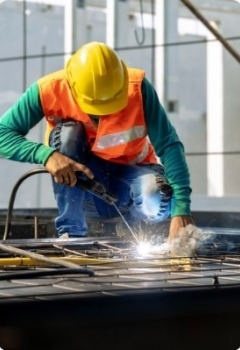Formwork and bar bending
 Magarey Enosh Universe employs professional foreign workers in a range of “wet work” trades in the construction sector, including formwork, bar bending, flooring and rendering, including skeleton frame works, utility preparation works (water, sewers, communication, air conditioning, etc.), works for laying environmental infrastructures such as sidewalks and curbstones, building of interior and exterior walls, rendering and paintwork.
Magarey Enosh Universe employs professional foreign workers in a range of “wet work” trades in the construction sector, including formwork, bar bending, flooring and rendering, including skeleton frame works, utility preparation works (water, sewers, communication, air conditioning, etc.), works for laying environmental infrastructures such as sidewalks and curbstones, building of interior and exterior walls, rendering and paintwork.
The industrialized technique in use today may be used to control raw materials and achieve “clean” construction that generates a reduced amount of dust and air pollution resulting from the construction process, also permitting construction in a relatively short time. Conventional construction of this type involves casting concrete into wooden molds, the molds being bonded to each other using cement and resulting in a slow work process.
What is formwork and bar bending?
Our personnel are skilled in formwork and bar bending, including castings of pile heads, safety fences, partitions and more.
Formwork is part of the construction process in which concrete is cast into forms (wooden or metal shapes) to form building parts such as walls, roofs, openings and more. Formwork is used for casting concrete details such as columns and steps.
Formwork is of great importance for ensuring that construction will be stable and to a high standard.
Bar bending is part of the construction process, involving casting of metal details such as frames and utility structures, iron castings will be used for casting the building parts such as pergolas, fences, windows and doors.
Bar bending work is highly important as it ensures structural stability and durability.
About formwork / forms in the construction process
Formwork is effectively the mold into which concrete is cast. Its function is to support the liquid concrete and maintain its shape during the casting until the concrete solidifies and gains sufficient strength to bear its own weight unassisted. Usually such a process will last about a day, and once the concrete solidifies the mold (formwork) is removed.
Formwork may consist of wooden boards or planks, molds made of steel and/or any other material such as bent metal sheeting, plastic or cardboard, which are commonly used for casting round concrete pillars. Sometimes, some forms will be concrete components, such as precast elements and bricks.
The formwork types used for casting will usually be chosen based on considerations of required concrete shape complexity, the number of repetitions of the same geometric shape that recurs in a given project / building, the cost of formwork personnel, whether using wooden forms that are installed and removed or expensive steel formwork, the desired texture type for the concrete if it is supposed to remain bare.
Formwork must withstand the pressure of the concrete, which tends to escape the confines of the forms. To this end, supports are commonly built around forms to prevent them from breaking once the concrete is cast into them. Such supports may be diagonal bars or steel bars that interconnect the boards through the casting cavity, which then stretch while the boards are pressed outward.
The importance of professional formwork and bar bending
Professional, skilled formwork will prevent wooden planks from splitting under the pressure of concrete. Also, high quality work will prevent the wooden frame from floating up, causing the concrete to spread under the mold, which will result in unnecessary costs and wasted work hours.
A skilled formworker knows how to mark the building frames, make markings for constructors, establish heights, install scaffolding, be familiar with the stability of the materials used to make the building, monitor dimensions and molds, make area and volume measurements and more.
